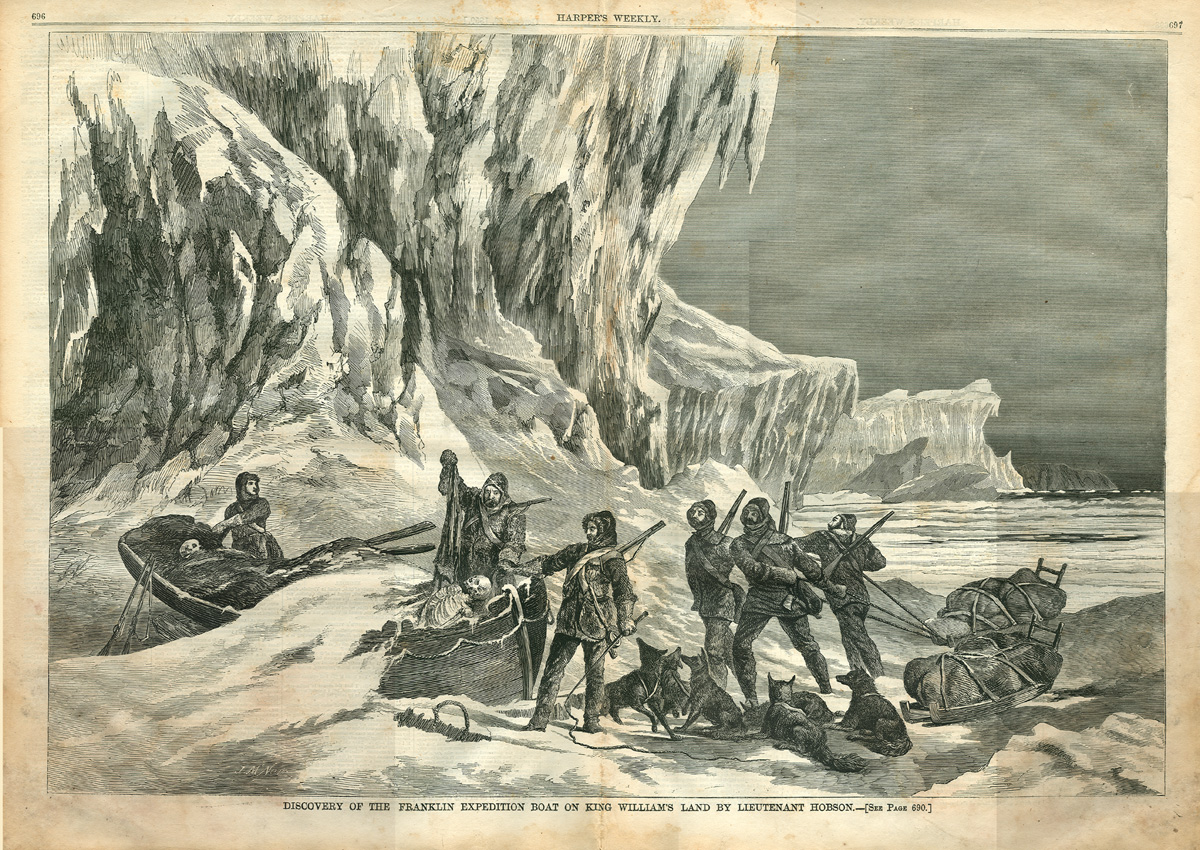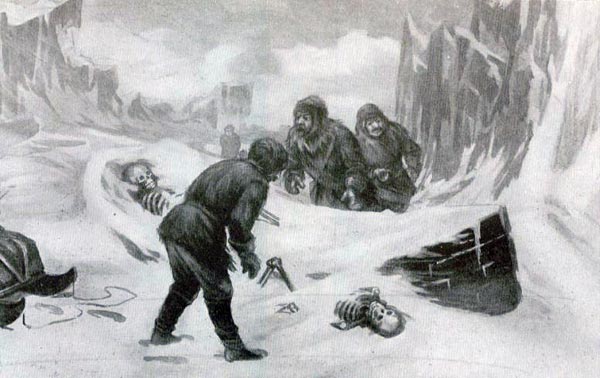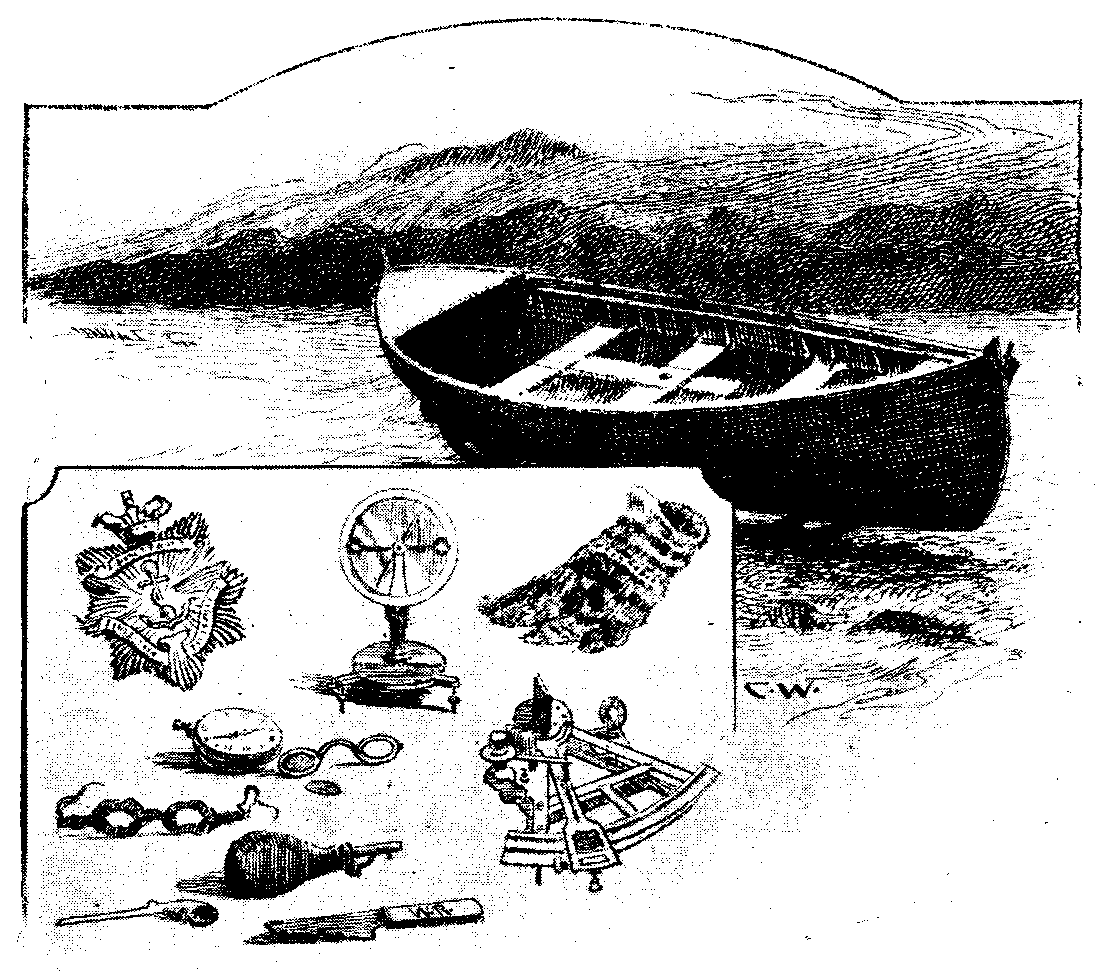Inspired by a recent discussion about if a picture which has appeared in an article the Daily Mirror, on which it appears a sledge with a skeleton inside, is actually related or not with the Franklin expedition or not, I decided to offer to the public a compilation of those illustrations and paintings which I currently know which show the boat found by Lieutenant Hobson, from the McClinctock expedition during his sledge trip to King William Island in 1859
The place has become one of the most characteristics ones in King William Island together with Victory point, Terror bay, Cape Felix and others. The location is now worldwide known as the "Boat place", and it has haunted the imagination of both, the witnesses of the finding and of the people who read in newspapers and narratives what was found there. The place has been revisited several times after by other searching expeditions but it never showed any substantial information which could help to solve the mystery about the fate of the Franklin expedition. The arrangement of the boat, the bizarreness and uselessness of its content and the position and state of its dead occupants is a mystery itself.
Nowadays this is thought to be the same archaeological site called NjLG3 which you can locate at the bottom of Erebus Bay. The location of the place and rest of Franklin relics are available in an interactive map here.
A detailed description of the boat and its content discovered by Hobson is described thoroughly in the narrative of the expedition "The Voyage of the Fox" or in Russell Potter´s blog here. But I summarize in few lines how McClintock described the sinister site:
in the morning of the 30th May we encamped alongside a large boat .../...This boat measured 28 feet long, and 7 feet 3 inches wide .../...The weight of the boat alone was about 700 or 800 lbs. only, but she was mounted upon a sledge of unusual weight and strength. there was in the boat that which transfixed us with awe, viz., portions of two human skeletons ! One was that of a slight young person ; the other of a large, strongly-made, middle-aged man. The former was found in the bow of the boat, but in too much disturbed a state .../...The other skeleton was in a somewhat more perfect state ; it lay across the boat, under the after-thwart, and was enveloped with cloths and furs. This would seem tohave been the survivor of the two men whose remains were lying in the boat. .../.. and there were two double-barrelled guns — one barrel in each loaded and cocked — standing muzzle upwards against the boat's side.
That was a creepy scene, no doubt. There was never elaborated an explainable and satisfying theory which could reasonably explain what happened, there. Why those two men were apparently abandoned, why all the useless things were present all around and why the boat was pointing north when the crews were suppossed to be retreating to the south?.
Contemporary pictures of the place where the boat was found are available in Robert Carlson´s blog here. Robert, during some time, performed several flights over the island in his brave and personal attempt to locate the lost ships, but of course, nothing remained after about 150 years of what disturbed so much McClintock and Hobson.
There are however some artistic licences which may find an easy explanation. Though McClintock nor Hobson could find any of the skulls belonging to the two skeletons, these are realisticaly drawn in all the sketches. Surely, the message wouldn´t have been properly conveyed to the avid public with the intensity needed through a headless skeleton crew.
Let´s analyse together all of those sketches and also some of the paintings.
1.- Harper's Weekly, depicts Lt. Hobson as he discovers a boat used by members of the missing Franklin Expedition
This is supposed to be the scene as depicted in the newspaper Harper´s Weekly. It is not clear when this picture was published.
 |
| This illustration, from Harper's Weekly, depicts Lt. Hobson as he discovers a boat used by members of the missing Franklin Expedition. From the Russell Potter scan of the original: www.ric.edu/faculty/rpotter/deathfull_sm.jpg |
I have read in an article that this particular sketch was published in "Harper Weekly" in the 20th of october of 1850. That, of course can´t possibly be true for two main reasons, the McClintock expedition discovered the boat in his expedition of 1857 and on the other hand the newspaper "Harper´s Weekly" began its activity with that name precisely that same year, in 1857. So surely, the illustration belongs to some edition of 1859, year on which the Fox came back home.
This second illustration shows the same event depicted almost identically, and surely by the same author, who by the way is unknown to me. It looks as if it were another frame of the same sequence:
|
“Discovery of the Franklin expedition boat.” New yorkFrom "Frozen Ocean" http://ve.tpl.toronto.on.ca/frozen_ocean/fo_s4f.htm 
In both of them you can see the same number of people, six explorers, six dogs, two sledges, two skeletons, a boat and two barrelled guns. But besides the fact that one is couloured and the other isn´t, you can notice that the postures of the men and the dogs are slightly different. I have no idea about which other newspaper was this second sketch published.
3.- Discovery of the bodies
Likely, this next one was made based on the previous drawings. I don´t have a clear idea from where this comes, surely from one of those numerous books which were published after McClintock´s findings and talked about the Franklin expedition. This time, again, six men are shown removing what could be pieces of canvas, a coat or some clothing, to show a skeleton inside the boat. On the floor, close to the clothes are what seems to be a pair of boots. A shinny Aurora Borealis in the backgrounf gives the whole scene a certain unrealistic air.
I haven´t been able to guess who was the author of this drawing, however the drawing has a name written at the bottom which seems to read "Bemable" or something like that. I leave this open to your own investigations.
4.- The discovery of Franklin's party. Source: Morris, Charles
Here, we have another case, this one appears in the book "Finding the North Pole" published in 1909 inside the chapter"The fate of the Sir John Franklin Expedition" in the page number 310. The creepy illustration appears over the name: "McClinctock finding skeletons of Sir John Franklin´s men":
Again we are before a fictional scene which show some survivors of the Franklin expedition not only fighting against the cold, scurvy, starvation and poisoned tins but also against a hungry polar bear. May this have been the inspiration of the Simmons novel?
7.- Découverte des restes de l'expédition Franklin. From Voyages et decouvertes outre - mer au XIX siecle we got, perhaps one of the more accurate representation of the finding, at least regarding the actual size of the boat:
A variation of this last one has been represented sometimes alone together with a window on its bottom which shows several of the Franklin expedition relics found, I guess that with the purpose of publishing it in some newspaper of the time. This sequel of the above sketch is signed with the initials: C.W.
If someone have any clue about its origin, please feel free to enlight me!.
|
And almost finally, following the advice of Russell Potter who kindly called my attention about this, I have included this picture, which is not a drawing nor a painting, but it could be considered the modern equivalent of them. The photo belongs the David Egan´s play "Tom´s a cold". These characters will be the ones who will be found later skelotonized in the boat. To know more about this play, please visit the Russell´s blog following the link under the picture.
| http://visionsnorth.blogspot.com.es/2011/01/toms-cold.html |
This was all I could gather till the moment, maybe I could find further more images while reading one of those many books about the Franklin expedition which have been written during so many years. For now, this is all I could find to show you all. If for any chance, you some day stumble upon a new sketch about it, please don´t be shy and tell me!
|










